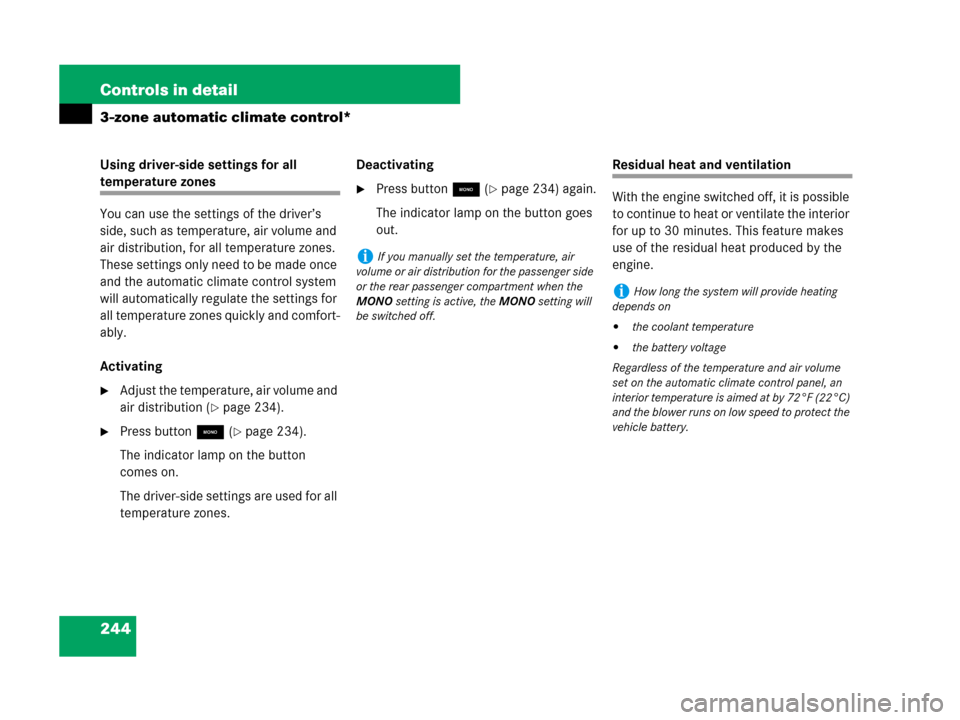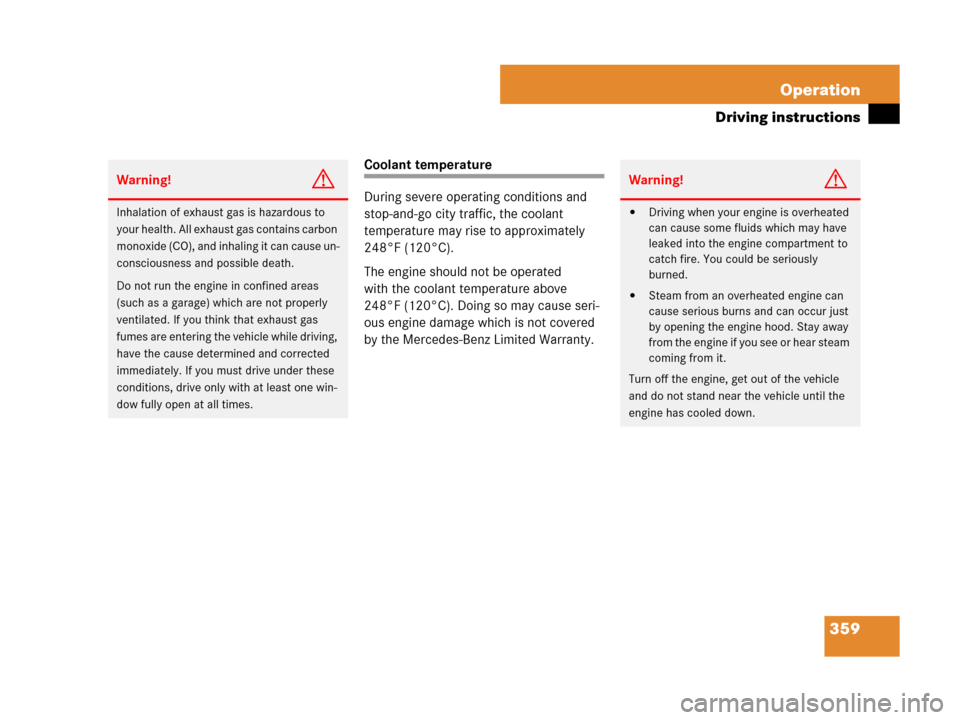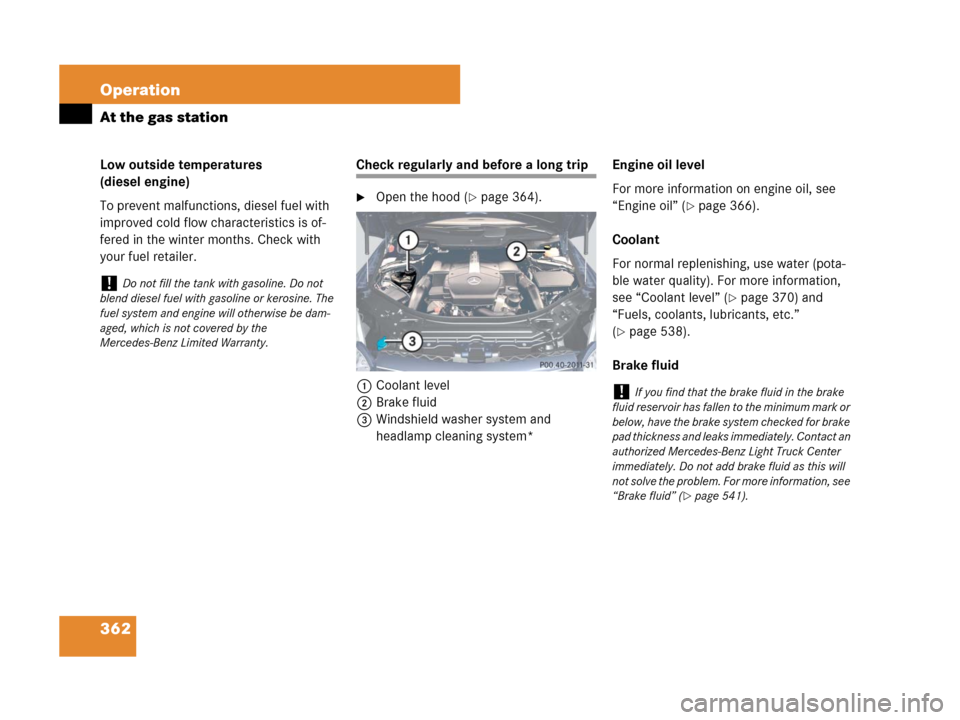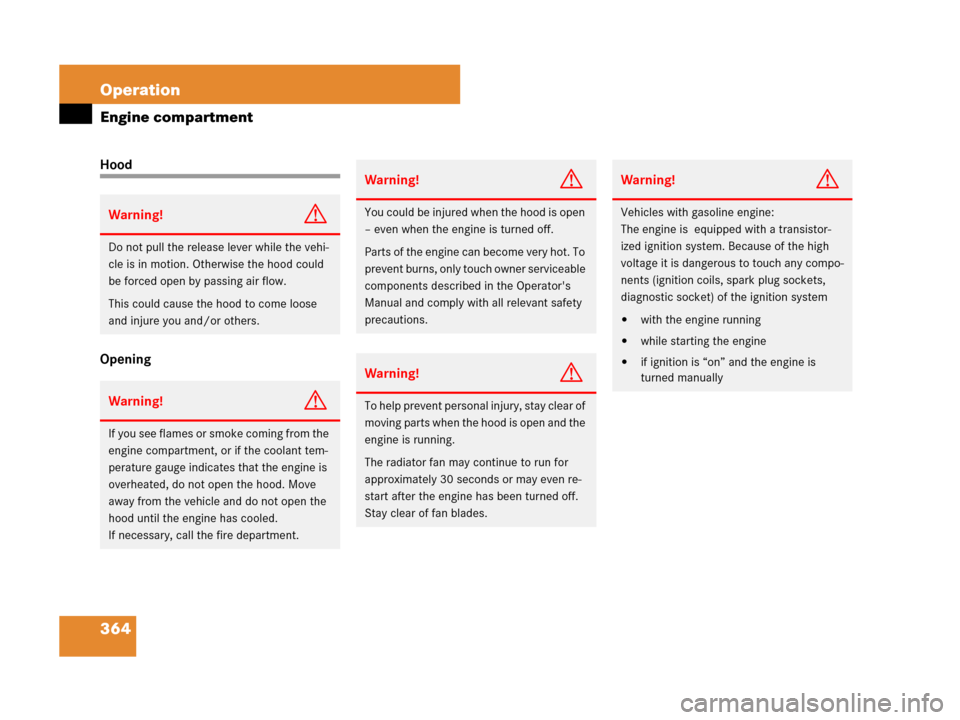Page 245 of 570

244 Controls in detail
3-zone automatic climate control*
Using driver-side settings for all
temperature zones
You can use the settings of the driver’s
side, such as temperature, air volume and
air distribution, for all temperature zones.
These settings only need to be made once
and the automatic climate control system
will automatically regulate the settings for
all temperature zones quickly and comfort-
ably.
Activating
�Adjust the temperature, air volume and
air distribution (
�page 234).
�Press button; (�page 234).
The indicator lamp on the button
comes on.
The driver-side settings are used for all
temperature zones.Deactivating
�Press button; (�page 234) again.
The indicator lamp on the button goes
out.
Residual heat and ventilation
With the engine switched off, it is possible
to continue to heat or ventilate the interior
for up to 30 minutes. This feature makes
use of the residual heat produced by the
engine.
iIf you manually set the temperature, air
volume or air distribution for the passenger side
or the rear passenger compartment when the
MONO setting is active, the MONO setting will
be switched off.
iHow long the system will provide heating
depends on
�the coolant temperature
�the battery voltage
Regardless of the temperature and air volume
set on the automatic climate control panel, an
interior temperature is aimed at by 72°F (22°C)
and the blower runs on low speed to protect the
vehicle battery.
Page 246 of 570
245 Controls in detail
3-zone automatic climate control*
Activating
�Switch off the ignition (�page 39).
�Press button9 (�page 234).
The indicator lamp on the button
comes on.
Deactivating
�Press button9.
The indicator lamp on the button goes
out.Rear automatic climate control
(second row)
The control panel is located at the rear of
the front center console.
Rear automatic climate control panel
iThe residual heat is automatically turned off:
�when the ignition is switched on
�after about 30 minutes
�if the coolant temperature is too low
�if the battery voltage drops
1Increasing air volume
2Air distribution and air volume
(automatic, manual)
3Air distribution (directs air through
the side air vents
4Right rear center air vent, adjustable
5Air distribution (directs air through
the footwells and side air vents)
6Rear automatic climate control
on/off
7Decreasing air volume
8Left rear center air vent, adjustable
9Indicator lamps for air volume
settings
aTemperature control
Page 360 of 570

359 Operation
Driving instructions
Coolant temperature
During severe operating conditions and
stop-and-go city traffic, the coolant
temperature may rise to approximately
248°F (120°C).
The engine should not be operated
with the coolant temperature above
248°F (120°C). Doing so may cause seri-
ous engine damage which is not covered
by the Mercedes-Benz Limited Warranty.
Warning!G
Inhalation of exhaust gas is hazardous to
your health. All exhaust gas contains carbon
monoxide (CO), and inhaling it can cause un-
consciousness and possible death.
Do not run the engine in confined areas
(such as a garage) which are not properly
ventilated. If you think that exhaust gas
fumes are entering the vehicle while driving,
have the cause determined and corrected
immediately. If you must drive under these
conditions, drive only with at least one win-
dow fully open at all times.
Warning!G
�Driving when your engine is overheated
can cause some fluids which may have
leaked into the engine compartment to
catch fire. You could be seriously
burned.
�Steam from an overheated engine can
cause serious burns and can occur just
by opening the engine hood. Stay away
from the engine if you see or hear steam
coming from it.
Turn off the engine, get out of the vehicle
and do not stand near the vehicle until the
engine has cooled down.
Page 363 of 570

362 Operation
At the gas station
Low outside temperatures
(diesel engine)
To prevent malfunctions, diesel fuel with
improved cold flow characteristics is of-
fered in the winter months. Check with
your fuel retailer.Check regularly and before a long trip
�Open the hood (�page 364).
1Coolant level
2Brake fluid
3Windshield washer system and
headlamp cleaning system*Engine oil level
For more information on engine oil, see
“Engine oil” (�page 366).
Coolant
For normal replenishing, use water (pota-
ble water quality). For more information,
see “Coolant level” (
�page 370) and
“Fuels, coolants, lubricants, etc.”
(
�page 538).
Brake fluid
!Do not fill the tank with gasoline. Do not
blend diesel fuel with gasoline or kerosine. The
fuel system and engine will otherwise be dam-
aged, which is not covered by the
Mercedes-Benz Limited Warranty.
!If you find that the brake fluid in the brake
fluid reservoir has fallen to the minimum mark or
below, have the brake system checked for brake
pad thickness and leaks immediately. Contact an
authorized Mercedes-Benz Light Truck Center
immediately. Do not add brake fluid as this will
not solve the problem. For more information, see
“Brake fluid” (
�page 541).
Page 365 of 570

364 Operation
Engine compartment
Hood
Opening
Warning!G
Do not pull the release lever while the vehi-
cle is in motion. Otherwise the hood could
be forced open by passing air flow.
This could cause the hood to come loose
and injure you and/or others.
Warning!G
If you see flames or smoke coming from the
engine compartment, or if the coolant tem-
perature gauge indicates that the engine is
overheated, do not open the hood. Move
away from the vehicle and do not open the
hood until the engine has cooled.
If necessary, call the fire department.
Warning!G
You could be injured when the hood is open
– even when the engine is turned off.
Parts of the engine can become very hot. To
prevent burns, only touch owner serviceable
components described in the Operator's
Manual and comply with all relevant safety
precautions.
Warning!G
To help prevent personal injury, stay clear of
moving parts when the hood is open and the
engine is running.
The radiator fan may continue to run for
approximately 30 seconds or may even re-
start after the engine has been turned off.
Stay clear of fan blades.
Warning!G
Vehicles with gasoline engine:
The engine is equipped with a transistor-
ized ignition system. Because of the high
voltage it is dangerous to touch any compo-
nents (ignition coils, spark plug sockets,
diagnostic socket) of the ignition system
�with the engine running
�while starting the engine
�if ignition is “on” and the engine is
turned manually
Page 371 of 570

370 Operation
Engine compartment
�Unscrew filler cap1 from filler neck.
�Add engine oil as required. Be careful
not to overfill with oil.
Be careful not to spill any oil when adding.
Avoid environmental damage caused by oil
entering the ground or water.
�Screw filler cap1 back on filler neck.
For more information on engine oil, see
“Technical data” section (
�page 538) and
(
�page 540).
Transmission fluid level
The transmission fluid level does not need
to be checked. If you notice transmission
fluid loss or gear shifting malfunctions,
have an authorized Mercedes-Benz Light
Truck Center check the automatic trans-
mission.Coolant level
The engine coolant is a mixture of water
and anticorrosion/antifreeze. To check
the coolant level, the vehicle must be
parked on level ground.
!Excess oil must be siphoned or drained off.
It could cause damage to the engine or
emission control system not covered by the
Mercedes-Benz Limited Warranty.Warning!G
In order to avoid any possibly serious burns:
�Use extreme caution when opening the
hood if there are any signs of steam or
coolant leaking from the cooling system,
or if the coolant temperature gauge indi-
cates that the coolant is overheated.
�Do not remove pressure cap on coolant
reservoir if coolant temperature is
above 158°F (70°C). Allow engine to
cool down before removing cap. The
coolant reservoir contains hot fluid and
is under pressure.
Page 372 of 570
371 Operation
Engine compartment
The coolant expansion tank is located on
the passenger side of the engine compart-
ment.
1Cap
2Coolant expansion tank
3Indicator wall
4Coolant level�Using a rag, turn cap 1 slowly approx-
imately one half turn counterclockwise
to release any excess pressure.
�Continue turning cap 1 counterclock-
wise and remove it.
Coolant level 4 is correct if the level:
�for cold coolant: reaches the top of
indicator wall 3 visible through the
filling opening
�for warm coolant: is approximately
0.6 in (1.5 cm) higher
�Add coolant as required.
�Replace and tighten cap 1.
For more information on coolant, see
“Coolants” (
�page 543).
�Using a rag, slowly open the cap approx-
imately 1/2turn to relieve excess pres-
sure. If opened immediately, scalding
hot fluid and steam will be blown out un-
der pressure.
�Do not spill antifreeze on hot engine
parts. Antifreeze contains ethylene gly-
col which may burn if it comes into con-
tact with hot engine parts.
Page 402 of 570

401 Operation
Tires and wheels
Tire and loading terminology
Accessory weight
The combined weight (in excess of those
standard items which may be replaced) of
automatic transmission, power steering,
power brakes, power windows, power
seats, radio, and heater, to the extent that
these items are available as
factory-installed equipment (whether
installed or not).
Air pressure
The amount of air inside the tire pressing
outward on each square inch of the tire.
Air pressure is expressed in pounds per
square inch (psi), or kilopascal (kPa) or
bars.
Aspect ratio
Dimensional relationship between tire
section height and section width
expressed in percentage.Bar
Another metric unit for air pressure. There
are 14.5038 pounds per square inch (psi)
to 1 bar; there are 100 kilopascals (kPa)
to 1 bar.
Bead
The tire bead contains steel wires wrapped
by steel cords that hold the tire onto the
rim.
Cold tire inflation pressure
Tire inflation pressure when your vehicle
has been sitting for at least 3 hours or
driven no more than 1 mile (1.6 km).
Curb weight
The weight of a motor vehicle with stan-
dard equipment including the maximum
capacity of fuel, oil, and coolant, and, if so
equipped, air conditioning and additional
optional equipment, but without passen-
gers and cargo.DOT (Department of Transportation)
A tire branding symbol which denotes the
tire meets requirements of the
U.S. Department of Transportation.
GAWR (G
ross Axle Weight Rating)
The GAWR is the maximum permissible
axle weight. The gross vehicle weight on
each axle must never exceed the GAWR for
the front and rear axle indicated on the
certification label located on the driver’s
door B-pillar.
GTW (G
ross Trailer Weight)
The GTW is the weight of the trailer plus
the weight of all cargo, equipment, luggage
etc. loaded on the trailer.